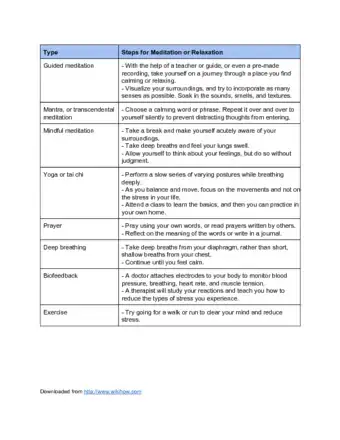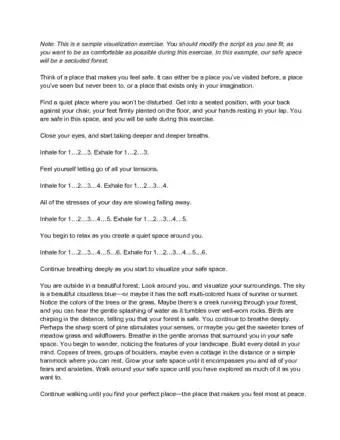This article was co-authored by Colleen Campbell, PhD, PCC. Dr. Colleen Campbell is the Founder and CEO of The Ignite Your Potential Centers, Career and Life Coaching based in the San Francisco Bay Area and Los Angeles. Colleen is an International Coach Federation accredited Professional Certified Coach (PCC). Colleen received her MA and PhD in Clinical Psychology from Sofia University and has been career coaching since 2008.
wikiHow marks an article as reader-approved once it receives enough positive feedback. This article received 18 testimonials and 98% of readers who voted found it helpful, earning it our reader-approved status.
This article has been viewed 716,606 times.
Mindful meditation is a great way to increase focus, decrease stress, and stimulate your creativity. Learning how to do mindful meditation takes some time and practice, but you can teach yourself how to do it. You can also learn how to incorporate mindfulness techniques into your everyday life, such as when you are eating, walking, or going about your other daily tasks.
Steps
Meditation Help
Choosing an Environment
-
1Select a location. Think about a place where you will not be interrupted or have distractions. It can be a quiet part of your home or next to a tree outside. Choose a place that feels peaceful and where you can detach from the hum of everyday life.
- If you are cultivating a meditation practice, consider creating a space dedicated to meditation. You can place inspirational or calming items on a special table, such as flowers or pictures of beautiful places. Soften the light by adding candles.
-
2Get comfortable. You may be stationary for several minutes at a time, and for this reason, it’s important to be comfortable. Pay attention to the room temperature to make sure it’s adequate. You may want to have a blanket around you or near you as your body temperature may drop. Have some pillows or cushions near you to make sitting more comfortable.
- Wear comfortable clothing that won’t bother you or distract you.
Advertisement -
3Set aside some time. You may want to start with just a five to 10 minute meditation and work up from there. Don’t choose to start meditating for an hour as this can seem overwhelming. Instead, choose small increments of time to commit to, and if you want, increase the time.
- Try setting a timer so that you will not be tempted to check the time during your meditation. Just make sure that the “end of meditation” timer is something gentle rather than a jarring alarm or buzzer. Try to find an alarm that sounds like soothing chimes or soft piano music.
-
4Try different postures. While many people associate meditation with sitting in lotus position (with legs crossed), there is not just one way to meditate. You can sit on the floor or in a chair, stand, walk, or lie down. Play around with different positions, using or not using cushions or pillows and find what feels most natural to you. There is no “wrong” way to meditate.
- While laying down is quite comfortable, make sure you don’t fall asleep! It’s quite common to begin meditation and then float off into dreamland.
Beginning Meditation
-
1Settle your mind. It may take you a little bit of time to settle in and begin to detach from all the things going on in your life. Especially if you’ve had a stressful day, you may find yourself thinking about what happened or about things that need to happen in the future. You may feel your emotions stirring. All of this is okay. Notice that your mind is dancing, and let it dance for a bit as you settle in.
- Keep in mind that it is okay if you feel a little strange about meditating. Just take a moment to identify the feelings you are having and then switch your focus to your physical position. Try to make yourself as comfortable as possible.
-
2Take some deep breaths. Bring your awareness to your breath, noticing the inhalations and exhalations of each breath. Feel how each breath flows in and out of your body, filling your lungs and then releasing through your throat and your mouth. Begin to lengthen and deepen each breath. Taking deep breaths helps settle and relax the mind and the body.[1]
- Observing your breath is also a mindfulness practice in itself. You can practice observing your breath for the entire length of the meditation.
-
3Realize that you are not your thoughts. As you meditate, remind yourself that you have control over what thoughts and emotions you choose to engage.[2] When you notice thoughts or emotions coming up that you do not wish to engage, release them and choose not to put your focus onto them.
- This insight can be helpful in realizing that you can change negative thoughts and that you can let them go.
- Don’t beat yourself up when you notice your mental stream of thoughts. Practice letting go of these mental experiences without judgment.
-
4Return to your breath. Any time you get distracted by noises, thoughts, or anything, go back to observing your inhalations and exhalations. Any time you experience unpleasant thoughts or emotions, return your focus to your breathing.
- When you focus on breathing, focus on neutrality. If thoughts come up while focusing on breathing, make sure you're maintaining the practice of not passing judgment on your thoughts, including on how you are practicing meditating. Judging yourself will interfere in your meditation session. Understand that it's common for people to get distracted or for thoughts to come up regarding their day.
- Remember that meditation is not a performance.[3]
-
5Focus on the present. One of the goals of mindfulness practices is to help you focus on the present moment. It’s easy for your mind and emotions to jump to the future or back into the past, but your body is always in the present moment. This is why many mindfulness practices are body-driven. If you find your mind wandering often, return to your body, especially your breath. Try to focus only on the present moment.[4]
Practicing Mindfulness Techniques
-
1Eat mindfully. Mindful eating may even help you to lose weight by helping you to slow down and really enjoy your food.[5] You can practice mindful eating with a piece of fruit, such as an apple.
- Hold the apple and look at it, observing the form, texture, or any writing that may be on it.
- Feel the apple in your hands, or perhaps against your lips.
- Bring it closer to your face and spend a few breaths smelling it. Notice if your body responds, such as salivating or increased desire to taste it.
- Finally, take a bite of the apple, noticing how it tastes, what it feels like, and if it’s enjoyable to chew it.
-
2Practice mindful walking. You can also meditate while walking. Try taking a walk and as you walk, pay attention to the way it feels to walk, feeling your muscles move, bend, and stretch. Slow your pace so you can focus on your movements and the sensation of your feet touching and leaving the ground.[6]
- Doing a walking meditation barefoot can heighten the experience and allow you to feel many more sensations such as the texture and the temperature of the ground.
-
3Focus on sensations. You can do sensation mindfulness meditation if you are experiencing pain or you want to tune in to your body. The skill can help reduce pain and tension in your body. Choose a part of your body to focus on, either internally or externally. Are sensations pleasant, unpleasant, or neutral? You can note "there is now a pleasant feeling" or "there is an ache here". Observe how the mind and body interact with these feelings.
- A similar method that applies to both first two body-focused foundations is a form of body scanning; namely, scanning the body up and down to examine sensations and then letting them go to pass onto another part of the body, or watching energy flow.[7]
- Instead of tuning out much of what surrounds you, tune in to each sense. Open your eyes and take in your surroundings, noticing any movement, colors, or objects that stand out to you. Notice any smells in the air. Notice any sounds, perhaps the hum of electricity, cars outside your window, or birds singing.[8]
-
4Make daily tasks a meditation. Anything can be a meditation if you do it mindfully. You can brush your teeth mindfully by tasting the toothpaste, feeling the bristles of the toothbrush, and feel the motion of your hand. Take a shower mindfully and notice all the ways you take care of your body during this time. Even driving to work can be a meditation: notice how you feel in the car, the way your body conforms to the seat, and observe the thoughts and emotions that you experience when confronted with traffic, and desired or undesired outcomes.
- Whenever you do a mindfulness practice, remember the most important part is being present. Come back to your breath and observe your thoughts and feelings without following them or judging them.
Expert Q&A
-
QuestionHow do you create a mindful environment?
 Colleen Campbell, PhD, PCCDr. Colleen Campbell is the Founder and CEO of The Ignite Your Potential Centers, Career and Life Coaching based in the San Francisco Bay Area and Los Angeles. Colleen is an International Coach Federation accredited Professional Certified Coach (PCC). Colleen received her MA and PhD in Clinical Psychology from Sofia University and has been career coaching since 2008.
Colleen Campbell, PhD, PCCDr. Colleen Campbell is the Founder and CEO of The Ignite Your Potential Centers, Career and Life Coaching based in the San Francisco Bay Area and Los Angeles. Colleen is an International Coach Federation accredited Professional Certified Coach (PCC). Colleen received her MA and PhD in Clinical Psychology from Sofia University and has been career coaching since 2008.
PhD in Clinical Psychology, Sofia University You can practice mindfulness no matter where you are. Mindfulness is really being in the here and now, and it can be very rejuvenating. It can be something as simple as if you're washing dishes, you focus on feeling the water and the soap. If you're walking, you could be paying attention to how your body feels—your legs, your feet, the air hitting your face, and the sounds around you.
You can practice mindfulness no matter where you are. Mindfulness is really being in the here and now, and it can be very rejuvenating. It can be something as simple as if you're washing dishes, you focus on feeling the water and the soap. If you're walking, you could be paying attention to how your body feels—your legs, your feet, the air hitting your face, and the sounds around you.
References
- ↑ http://www.webmd.com/balance/stress-management/stress-management-breathing-exercises-for-relaxation
- ↑ http://greatergood.berkeley.edu/topic/mindfulness/definition
- ↑ https://www.psychologytoday.com/articles/200811/the-art-now-six-steps-living-in-the-moment
- ↑ https://www.psychologytoday.com/articles/200811/the-art-now-six-steps-living-in-the-moment
- ↑ http://greatergood.berkeley.edu/topic/mindfulness/definition
- ↑ http://greatergood.berkeley.edu/topic/mindfulness/definition
- ↑ http://greatergood.berkeley.edu/topic/mindfulness/definition
- ↑ http://greatergood.berkeley.edu/topic/mindfulness/definition
About This Article
To do mindful meditation, get comfortable in a quiet place and take a few deep breaths. Focus on each breath as you inhale and exhale, which will help you turn your attention away from your thoughts. Don't worry if you catch yourself getting lost in your thoughts. Just redirect your attention back to your body and breathing, and try not to judge the thoughts you're having. Instead, focus on the present moment as much as possible. To learn how to practice different mindfulness techniques in your day-to-day life, scroll down!
























-Step-18-Version-2.webp)






















































